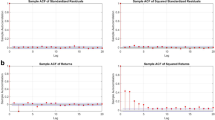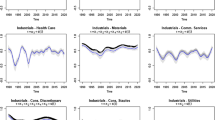Abstract
This paper combines copula functions with GARCH-type models to construct the conditional joint distribution, which is used to estimate Value-at-Risk (VaR) of an equally weighted portfolio comprising crude oil futures and natural gas futures in energy market. Both constant and time-varying copulas are applied to fit the dependence structure of the two assets returns. The findings show that the constant Student t copula is a good compromise for effectively fitting the dependence structure between crude oil futures and natural gas futures. Moreover, the skewed Student t distribution has a better fit than Normal and Student t distribution to the marginal distribution of each asset. Asymmetries and excess kurtosis are found in marginal distributions as well as in dependence. We estimate VaR of the underlying portfolio to be 95% and 99%, by using the Monte Carlo simulation. Then using backtesting, we compare the out-of-sample forecasting performances of VaR estimated by different models.
Similar content being viewed by others
References
Akaike, H. (1973). Information theory and an extension of the maximum likelihood principle. In The second international symposium on information theory (pp. 267–281). Budapest: Akademiai Kiado.
Ang, A., & Chen, J. (2002). Asymmetric correlations of equity portfolios. The Review of Financial Studies, 63, 443–494.
Bastianin, A. (2009). Modelling asymmetric dependence using copula functions: an application to value-at-risk in the energy sector. FEEM Working Paper.
Berg, D., & Bakken, H. (2006). Copula goodness-of-fit tests: a comparative study. Working Paper.
Blanco, C., & Ihle, G. (1999). How good is your VaR? using backtesting to assess system performance. Financial Engineering News, 1–2.
Bollerslev, T., Engle, R. F., & Nelson, D. B. (1994). ARCH models. In R. F. Engle & D. L. McFadden (Eds.), Handbook of econometrics (Chapter 49, pp. 2959–3038). Amsterdam: Elsevier.
Campbell, S. D. (2006). A review of backtesting and backtesting procedures. The Journal of Risk, 9, 1–18.
Cherubini, U., Luciano, E., & Vecchiato, W. (2004). Copula methods in finance. London: Wiley.
Christoffersen, P. F. (1998). Evaluating interval forecasts. Intermountain Economic Review, 39, 841–862.
Deheuvels, P. (1979). La Fonction de dépendance empirique et ses propriétés: un test non paramétrique d’indépendance. Bulletin de la Classe Des Sciences. Académie Royale de Belgique, 65, 274–292.
Dias, A. (2004). Copula inference for finance and insurance. Unpublished PhD Thesis ETH, Swiss Federal Institute of Technology, Zurich.
Diebold, F. X., Gunther, T., & Tay, A. (1998). Evaluating density forecasts with applications to financial risk management. Intermountain Economic Review, 39, 863–883.
Durrleman, V., Nikeghbali, A., & Roncalli, T. (2000). Which copula is the right one? Working Paper.
Embrechts, P., Lindskog, F., & McNeil, A. J. (2003). Modelling dependence with copulas and application to risk management. In S. T. Rachev (Ed.), Handbook of heavy tailed distribution in finance. Amsterdam: Elsevier.
Embrechts, P., McNeil, A. J., & Straumann, D. (1999). Correlation and dependency in risk management: properties and pitfalls. In M. Dempster & H. Moffatt (Eds.), Risk management: value at risk and beyond. Cambridge: Cambridge University Press.
Engle, R. F. (1982). Autoregressive conditional heteroscedasticity with estimates of the variance of UK inflation. Econometrica, 50, 987–1007.
Fantazzini, D. (2008). Dynamic copula modelling for value at risk. Frontiers in Finance and Economics, 5, 72–108.
Fermanian, J.-D. (2005). Goodness-of-fit tests for copulas. Journal of Multivariate Analysis, 95, 119–152.
Fisher, R. A. (1932). Statistical methods for research workers. Edinburgh.
Genest, C., Rémillard, B., & Beaudoin, D. (2009). Goodness-of-fit for copulas: a review and power study. Insurance. Mathematics & Economics, 44, 199–213.
Glosten, L., Jagannathan, R., & Runkle, D. (1993). On the relation between the expected value and the volatility on the nominal excess returns on stocks. The Journal of Finance, 48, 1779–1801.
González-Rivera, G., Lee, T. H., & Mishra, S. (2004). Forecasting volatility: a reality check based on option pricing, utility function, value-at-risk, and predictive likelihood. International Journal of Forecasting, 20, 629–645.
Grégoire, V., Genest, C., & Gendron, M. (2008). Using copulas to model price dependence in energy markets. Energy Risk, 5, 58–64.
Hansen, B. E. (1994). Autoregressive conditional density estimation. Intermountain Economic Review, 35, 705–730.
Harvey, C. R., & Siddique, A. (2000). Conditional skewness in asset pricing tests. The Journal of Finance, 55, 1263–1295.
Hong, Y., Tu, J., & Zhou, G. (2007). Asymmetries in stock returns: statistical tests and economic evaluation. The Review of Financial Studies, 20, 1547–1581.
Huard, D., Évin, G., & Favre, A.-C. (2006). Bayesian copula selection. Computational Statistics & Data Analysis, 51, 809–822.
Hull, J., & White, A. (1998). Value-at-risk when daily changes in market variables are not normally distributed. The Journal of Derivatives, 5, 9–19.
Joe, H. (1997). Multivariate models and dependence concepts. London: Chapman and Hall.
Jondeau, E., & Rockinger, M. (2006). The copula-GARCH model of conditional dependencies: an international stock market application. Journal of International Money and Finance, 25, 827–853.
Jorion, P. (2007). Value at risk: the new benchmark for managing financial risk (3rd ed.). New York: McGraw-Hill.
Kupiec, P. (1995). Techniques for verifying the accuracy of risk measurement models. The Journal of Derivatives, 2, 173–184.
Lopez, J. (1998). Methods for evaluating value-at-risk estimates. Federal Reserve Bank of New York Research Paper, no. 9802.
McNeil, A., Frey, R., & Embrechts, P. (2005). Quantitative risk management: concepts, techniques and tools. New Jersey: Princeton University Press.
Mendes, B. V. M., & Souza, R. M. (2004). Measuring financial risks with copulas. International Review of Financial Analysis, 13, 27–45.
Nelsen, R. B. (1998). An introduction to copula. New York: Springer.
Patton, A. J. (2001). Applications of copula theory in financial econometrics. Unpublished PhD Thesis, University of California, San Diego.
Patton, A. J. (2004). On the out-of-sample importance of skewness and asymmetric dependence for asset allocation. Journal of Financial Economics, 2, 130–168.
Patton, A. J. (2006a). Modelling asymmetric exchange rate dependence. Intermountain Economic Review, 47, 527–556.
Patton, A. J. (2006b). Estimation of multivariate models for time series of possibly different lengths. Journal of Applied Econometrics, 21, 147–173.
Rosenblatt, M. (1952). Remarks on a multivariate transformation. Annals of Mathematical Statistics, 23, 470–472.
Schwarz, G. (1978). Estimating the dimension of a model. Annals of Statistics, 6, 461–464.
Sklar, A. (1959). Fonctions de repartition à n dimensions et leurs marges. Publications de L’Institut de Statistique de L’Université de Paris, 8, 229–231.
Stoyanov, S. V., Racheva-Iotova, B., Rachev, S. T., & Fabozzi, F. J. (2010). Stochastic models for risk estimation in volatile markets: a survey. Annals of Operation Research, 176, 293–309.
Author information
Authors and Affiliations
Corresponding author
Additional information
Supported by the National Natural Science Founation of China (Grant No. 70821001).
Rights and permissions
About this article
Cite this article
Lu, X.F., Lai, K.K. & Liang, L. Portfolio value-at-risk estimation in energy futures markets with time-varying copula-GARCH model. Ann Oper Res 219, 333–357 (2014). https://doi.org/10.1007/s10479-011-0900-9
Published:
Issue Date:
DOI: https://doi.org/10.1007/s10479-011-0900-9




